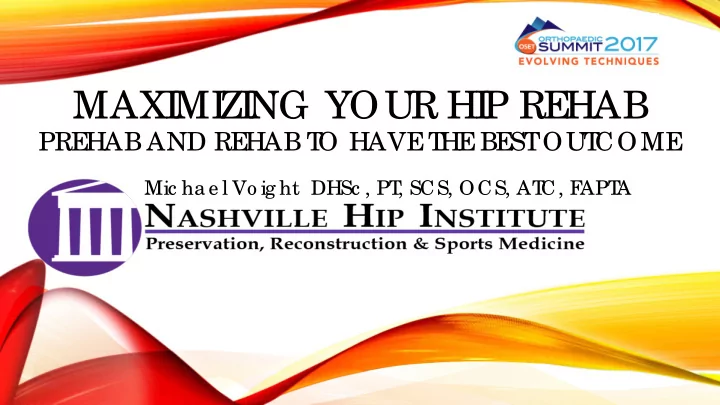

MAXI MI ZI NG YOUR HI P RE HAB PRE HAB AND RE HAB T O HAVE T HE BE ST OUT COME Mic ha e l Vo ig ht DHSc , PT , SCS, OCS, AT C, F APT A
I HAVE NO RELEVANT FINANCIAL RELATIONSHIPS TO DISCLOSE.
A SPECIAL THANKS TO MY FRIEND & MENTOR DR. THOMAS BYRD I have been able to see farther because I have stood on the shoulders of giants!
WHY BOTHER WITH PREHAB? • Once diagnosed with dysfunction - degenerative changes may start to occur at an accelerated rate. • You may be initiating treatment on the beginning of a steep downslope that cannot be reversed. • Opportunity to address extra-articular symptoms/pathology allow for a better/smoother post-op rehab: • Soft tissue pain and restrictions • Significant capsular restrictions • Hip and core weakness • Non-hip pain and dysfunction • SIJ, Lumbar Spine, etc • Movement pattern dysfunctions (need to identify compensations)
MOVEMENT PATTERN DYSFUNCTION Traditional rehab measures of (ROM) and strength are not able to measure fundamental changes in motor control following injury. (Compensatory Movement Patterns)
MOVEMENT PATTERN DYSFUNCTION Correcting compensations and improving movement quality may alter hip joint loading, reducing the likelihood of further joint damage and OA, resulting in a longer active lifestyle
MOVEMENT PATTERN DYSFUNCTION LOW VS. HIGH THRESHOLD Testing for & understanding the difference between low and high threshold activation strategy is a very important part of rehab. I f the pa tie nt is using the wro ng stra te g y fo r the ta sk, the y will no t o nly b y ine ffic ie nt, b ut the y c a n ma ke the injury wo rse a nd c a use mo re ha rm. Mo ve me nt sc re e ning a nd pe rfo rma nc e te sting will c o nfirm the c o rre c t a ppro a c h Do n’ t a ssume !
MOVEMENT PATTERN DYSFUNCTION DIFFERENTIATE LOW VS. HIGH THRESHOLD SLOW MOTOR UNITS FAST MOTOR UNITS FUNCTION Low threshold recruitment High threshold recruitment Contraction Speed slow fast Contraction Force low high Recruitment primarily recruited at low % of MVC (< 25%) increasingly recruited at higher % of MVC (40 + %) or if plan to perform a fast Dominance movement Recruitment Threshold low (sensitive) high (insensitive) - easily activated - requires higher stimulus Fatigability fatigue resistant fast fatiguing control of normal functional postures & rapid or accelerated movement ROLE unloaded movements & high load activity
CHOOSING THE RIGHT STRATEGY Skipping lo w-thre sho ld tra ining will re sult in c o mpe nsa tio n a nd o ve r use o f hig h- thre sho ld stra te g ie s to c o mple te the ta sk a t ha nd. T his te a c he s the b o dy to utilize g lo b a l • (prime mo ve r) musc le s a s b o th mo ve rs AND sta b ilize rs. Ove r time this ma y le a d to dysfunc tion, pa in, a nd/ or injury & re c urra nc e .
RE CRUIT ME NT IS MODUL AT E D BY T HE HIGHE R CE NT RAL NE RVOUS SYST E M (CNS) AND INF L UE NCE D BY T HE AF F E RE NT PROPRIOCE PT IVE SYST E M. Low threshold motor control does not change peripheral muscle structure to a great extent but improves CNS recruitment of muscles to fine tune muscle coordination and improve the efficiency of movement. • Movement control tests challenge the low threshold motor control system, testing the CNS recruitment of muscles.
HIP MOVEMENT SCREENING WHERE DO WE BEGIN? The screen comprises ten tests: • Single leg stance • Forward bend – toe touch • Small knee bend (SKB) • SKB with trunk rotation • Deep squat • Standing hip flexion to 110° • Sitting hip flexion to 110 • Side-lying hip abduction with the leg laterally rotated • Side-lying hip abduction with the leg medially rotated. • Single leg bridge
EXAMPLE: DEEP SQUAT TEST To be considered a complete full deep squat you must see the following: • No loss of UE start position • Upper torso is parallel with tibia or towards vertical. • No thoracic flexion • Thigh/Femur goes below horizontal – breaks parallel • No loss of sagittal plane alignment • Knees are aligned over feet Also: • Feet are pointing forward • Heels stay on the ground • No excessive effort, weight shift, or motor control Pa tie nts with F AI de mo nstra te d le ss sq ua t de pth a nd a lte re d lumb o -pe lvic kine ma tic s.
POOR OVERHEAD DEEP SQUAT
Example: Bridge w/ Leg Extension Test If the pelvis on the unsupported side drops or the support leg shakes this indicates instability in the glutes on the support side. • If the support leg hamstrings or lower back start to cramp, this indicates inhibition of the glutes and recruitment of synergistic muscles – LOOK FOR CRAMPING.
Bridge w/ Leg Extension Test
CONCLUSIONS Once you have completed the movement screening, you should be able to make the following conclusions: • Where you should start your treatment protocols. Movement screening provides the basis for determining the best pre- operative rehabilitation to correct compensations .
Recommend
More recommend